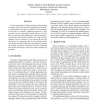Free Online Productivity Tools
i2Speak
i2Symbol
i2OCR
iTex2Img
iWeb2Print
iWeb2Shot
i2Type
iPdf2Split
iPdf2Merge
i2Bopomofo
i2Arabic
i2Style
i2Image
i2PDF
iLatex2Rtf
Sci2ools
ETFA
2008
IEEE
2008
IEEE
Two camera system for robot applications; navigation
Current approaches to feature detection and matching in images strive to increase the repeatability of the detector and minimize the degree of outliers in the matching. In this paper we present a conflicting approach; we suggest that a lower performance feature detector can produce a result more than adequate for robot navigation irrespectively of the amount of outliers. By using an FPGA together with two cameras we can remove the need for descriptors by performing what we call spurious matching and the use of 3D landmarks. The approach bypasses the problem of outliers and reduces the time consuming task of data association, which slows many matching algorithms.
| Added | 29 May 2010 |
| Updated | 29 May 2010 |
| Type | Conference |
| Year | 2008 |
| Where | ETFA |
| Authors | Jörgen Lidholm, Fredrik Ekstrand, Lars Asplund |
Comments (0)

